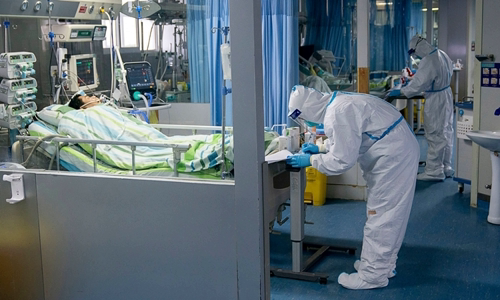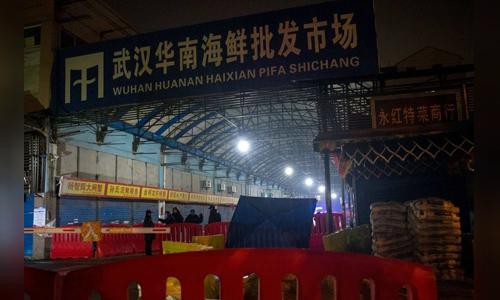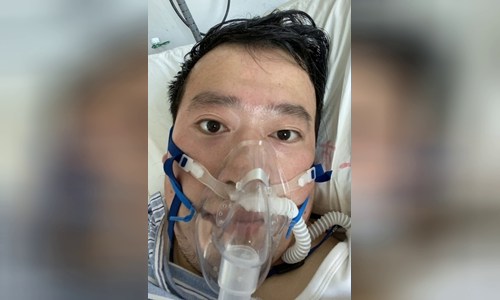From December 30, 2019, Dr. Ly Van Luong warned his former classmates at medical school about a mysterious disease that left seven people hospitalized.
"They were isolated in the emergency department," Li wrote in an online chat group with classmates.

Medical workers treat patients at hospitals in Wuhan on January 24 Photo: Xinhua
"It's scary. Is SARS coming back?", A respondent mentioned the 2002 outbreak in China that killed about 800 people.
That very night, Wuhan City health officials summoned Dr. Li, asking to know why he shared the information. Three days later, the police forced Li to sign a minutes acknowledging his warning action was "illegal."
This outbreak is not SARS, but it is also caused by a strain of corona virus. The outbreak then spread throughout Wuhan, nationwide and globally, killing at least 362 people, more than 17,000.
Through more than 20 interviews with residents, physicians and Wuhan officials, NYTimes journalists Chris Buckley and Steven Lee Myers built a panorama of Chinese officials' processing delays in The first 7 weeks since the outbreak. The first case appeared in early December. By the time official took action on January 20, the disease had become a serious threat.
At a critical time, officials decided to keep the information private rather than openly face the crisis. Experts say that because there was no strong move to warn the public and health experts in the early stages, the Chinese government lost a "golden opportunity" to curb the epidemic.
"The problem here is the lack of action," said Yanzhong Huang, an expert from the Council on Foreign Relations. "Wuhan Health Department does not warn people about the threat."
On the last day of 2019, after Dr. Ly's message was shared online, Wuhan officials focused on controlling information. Wuhan police announced they were investigating eight people for spreading "unfounded rumors" about the outbreak.
That same day, the Wuhan Health Committee announced 27 people with unexplained pneumonia, but added that the situation was not alarming. "The disease is preventable and manageable," the statement states.
Li, an ophthalmologist, returned to work after being reprimanded. On 10/1, he treated a woman with glaucoma. He did not know that she had a new strain of corona virus. Her daughter was infected, and so was he.
At the end of December 2019, Hu Xiaohu, who sold processed pork at Hainan seafood market, Wuhan City, felt that something was wrong. Many people in the market had prolonged fever, some were isolated at the hospital but no one understood why.
The market is located in a newly built area of the city, near apartment buildings and shops catering to the middle class. Market for meat, poultry, fish and wildlife. According to the report of the city epidemic control center, the hygiene here is very poor with weak ventilation, garbage dumped on the wet floor.
At hospitals in Wuhan, doctors were puzzled when accepting patients with symptoms of viral pneumonia but did not improve after taking conventional treatments. They soon realized that many patients had something in common: They worked at Hoa Nam market.
On January 1, police appeared at the market along with public health officials and closed it. Local officials announced that the market was cleaned because of the pneumonia epidemic. That morning, workers in protective clothing washed the stalls and sprayed disinfectants.
To the public, this was the government's first response to an outbreak. A day earlier, officials warned the World Health Organization (WHO) office in Beijing about the outbreak.
City officials expressed optimism in the announcement. They said the virus was stopped at the outbreak, the risk was limited, there was no evidence that the virus was transmitted from person to person.

Hoa Nam Seafood Market in Wuhan on January 11 Photo: AFP
"Showing optimism and confidence without data is a very dangerous strategy," said Alexandra Phelan, a lecturer at Georgetown University.
Nine days after the market was closed, a man who used to shop here became the first victim to die of corona virus, according to the Wuhan Health Commission's report. The man Zeng, 61, suffered from chronic liver disease and had an abdominal tumor, was hospitalized with a high fever and had trouble breathing.
Authorities revealed the man's death two days later. But they did not mention an important detail: Mr. Zeng's wife had similar symptoms 5 days after his illness. She has never been to Hoa Nam market.
More than 30 km from the market, scientists at Wuhan Institute of Virology studied samples from patients in the city, including Zheng-Li Shi, a former researcher on the origin of the SARS virus that appeared in the province. Guangdong in 2002.
While the public was still dim about the new virus, she and her colleagues quickly linked the data to conclude that the new virus was related to the SARS pandemic virus and that the original host might be a bat. The SARS epidemic began when a strain of the corona virus spread from bat to civet and from civet to human when they were sold at a market in Guangdong. It is possible that the new virus will follow a similar path - it may originate from animals in the Flower Market or similar markets.
At the same time, Dr. Li and medical experts in Wuhan tried to warn colleagues and others when the government did not do so. Lu Xiaohong, head of the gastroenterology department at the No. 5 City Hospital, told China Youth Daily that before December 25, 2019, she had heard the news that health workers had been infected, three weeks before the primary right to acknowledge the truth. She did not speak publicly but cautiously warned a school.
By the first week of January, the emergency department at the 5th hospital was full of people: cases involving members of the same family, clearly showing the virus spreading from person to person - what the government said is not likely.
No one realized how serious it was until it was too late to stop. "I realize we underestimate the enemy," she said.
At the Wuhan Virological Institute, Shi and his colleagues isolated the gene sequence of the virus strain in the first week of January, using samples from seven patients, six of whom were vendors at the South China market.
On January 7, scientists started calling the virus 2019-nCoV. Four days later, the team shared the virus's genetic structure in a public database for scientists everywhere to use. This helps world scientists study viruses and quickly share their findings.
But as the scientific community hurriedly developed its way of testing positive cases for nCoV, political leaders were still hesitant to take action.
As the nCoV spread in early January, Wuhan mayor Chu Tien Vuong was preparing to present the city's future health plan. This period of time was a "political season" in China, when officials gathered for People's Council meetings. This is not the right time to have bad news.
When Zhou read the annual report to the Wuhan City People's Council on January 7, he promised top medical schools, the World Health Expo and a future industrial park for companies. medical. He and other officials did not mention the outbreak.
"Politics must always be number one," Hubei provincial chief Wang Xiaodong told officials on January 17. "Political issues at any time are the most core."
Shortly thereafter, Wuhan still held a banquet with the participation of 40,000 families in an effort to set a world record. Experts often refer to the event as evidence that local leaders have taken the disease lightly.

Doctor Li Wenliang at the hospital in Wuhan last weekend Photo: NYTimes
"We know the real situation is not like that!", An anonymous doctor in Wuhan sent a complaint to the National Health Commission on the government's website, describing the number of people with unusual chest tightness. increase from 12/1.
But even people who are infected get "lulled". When Dong Guanghe had a fever on January 8 in Wuhan, the family did not appear alarmed. He was treated in a hospital and later allowed to go home. Ten days later, Mr. Dong's wife had similar symptoms. "The reports said nothing about the seriousness of the disease," Mr. Dong's daughter said. "I thought my dad had the common cold."
Even professionals have faith in government announcements. "If there are no new cases within the next few days, the epidemic will end," said Guan Yi, a professor of infectious diseases at the University of Hong Kong. WHO statements during this period also echoed the reassuring words of Chinese officials.
But in fact, the epidemic has spread. Thailand detected the first nCoV infection outside of China on January 13. The first deaths and the spread of the disease abroad attracted the attention of top officials in Beijing. The central government sent famous epidemiologist Chung Nam Son, considered a hero in the fight against SARS, to Wuhan to assess the situation.
When Chung arrived in Wuhan on January 18, the tone of the local officials changed dramatically. A health conference in Hubei Province that day urged health workers to make the epidemic a priority. An internal document from Wuhan Hiep Hoa Hospital warns that nCoV can be transmitted via saliva.
On January 20, anxiety exploded in public. Chung Nam Son said in an interview on state television that the virus is definitely transmitted from person to person. Worse, a patient has infected at least 14 medical staff.
Chinese President Xi Jinping, who had just returned from a visit to Myanmar, issued the first translation statement with the brief instruction "full effort" to prevent the epidemic. After Xi issued instructions, the authorities took drastic action. At that time, the death toll was three. 11 days later, this number has risen to over 200.
In Wuhan, the city suspends group tours. Residents began to wear masks. Guan Yi, a Hong Kong expert who spoke optimistically about the epidemic, was worried. He went to another food market in Wuhan and was shocked at the subjectivity of everyone. He told city officials that the epidemic was out of control and would leave. "I hurriedly booked a ticket," he said.
Two days later, the city was frozen. Many Wuhan residents said they did not grasp the severity of the epidemic until the city blockade. The crowd rushed to the airport and the train station to leave before the morning of January 23. Hospitals are full of worried people who come to check if they have nCoV.
"We don't wear masks at work because that will scare customers," Yu Haiyan, a waitress in a rural area in Hubei, said of the days before the city was frozen. "It wasn't until they sealed off Wuhan that I thought 'this outbreak is really serious, this is no ordinary virus'."
Wuhan Mayor Chu Tien Vuong then claimed responsibility for the delay in reporting the translation scale, but he said he had to follow the rules. The provincial government only publishes the epidemic after it is approved by the central government. "After I get the information, I can only publish it with permission," he said.
As the crisis worsened, Dr. Li's warning from the previous two months was no longer considered reckless. A commentary on the Chinese Supreme Court's social network criticized the Wuhan police's investigation of Dr. Li and his friends for spreading "rumors".
"If the public listened to this 'rumor' at the time and took measures such as wearing masks, strict disinfection and avoiding going to wildlife markets, we could have prevented and controlled it. spread the virus better, "the commentary reads.
Doctor Li is 34 years old and has a child. His wife was born in the summer. Now he is being treated at the hospital he works. He felt disgusted about the police action. "If officials release information about the disease earlier, the situation will be much better. It needs to be more open and transparent," he said.



 RommelCPacho
RommelCPacho







